Brief

Survival. That’s the singular focus of many businesses at the moment. If the stunning drop in global demand hasn’t already taken away a significant chunk of your revenue, it very well might in the future, depending on how long the Covid-19 pandemic clamps down on activity. Most portfolio companies are preoccupied with protecting employees, stabilizing the business, cutting costs and making things as easy as possible for customers. Daily triage leaves little time to think about anything else.

Macro Surveillance Platform
For more detail on the business implications of coronavirus from Bain’s Macro Trends Group, log on to the Macro Surveillance Platform. Learn more about the platform >
Yet there is plenty else to think about. A paramount challenge in a time of crisis is to avoid making decisions you’ll regret later. When the walls are caving in, it’s difficult to see the bigger picture—how the world around you is changing and how choices made today may affect your competitive positioning and growth prospects when the storm eventually clears. John F. Kennedy used to pepper his speeches with the observation that the word crisis in Chinese is composed of two characters: danger and opportunity. But avoiding the former and capturing the latter depends on doing two things at once. Firms have to both act now and plan now (see Figure 1).
During the Covid-19 crisis, private equity firms and their portfolio companies must act now and plan now simultaneously

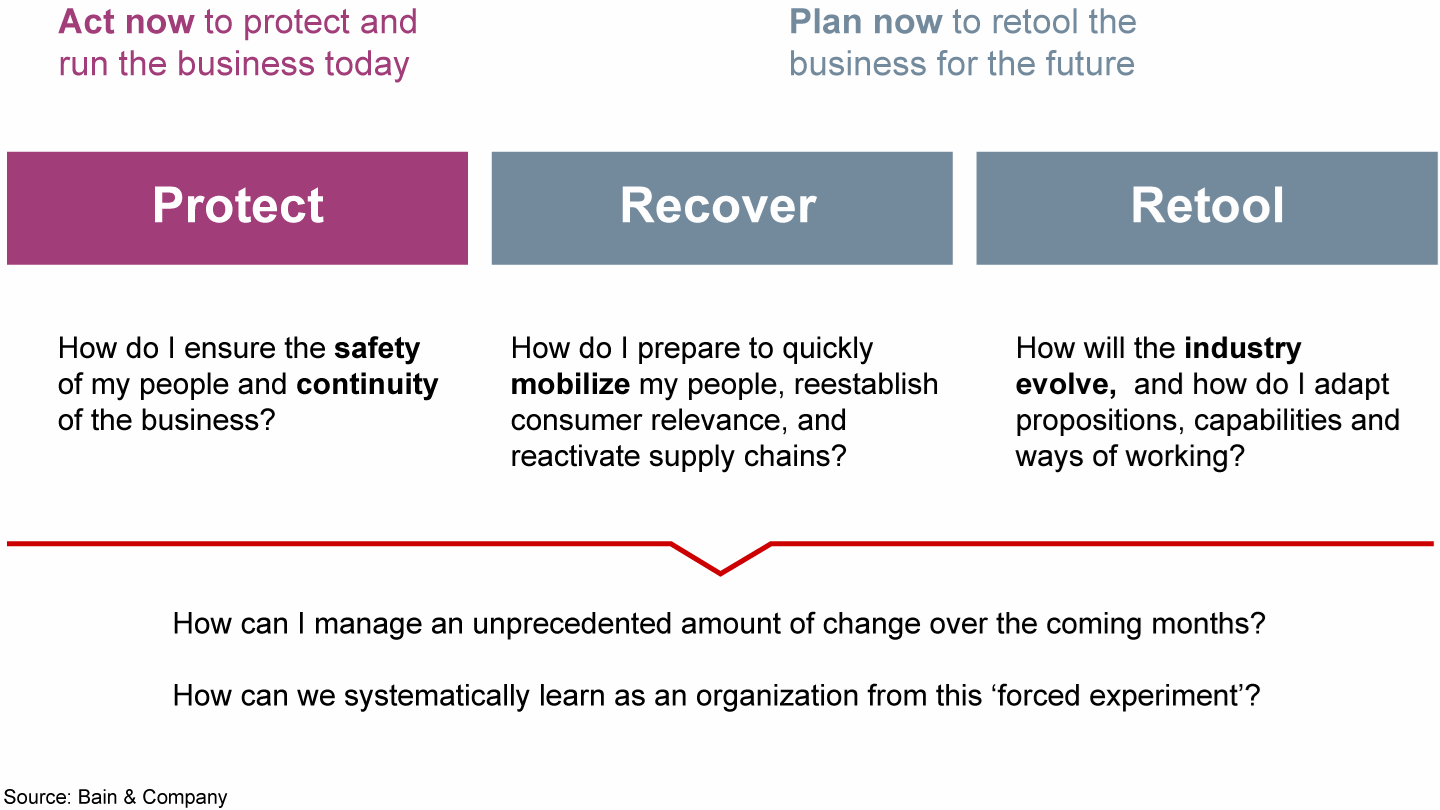
For PE firms, that means taking some of the burden off of portfolio companies. Their leaders are understandably swamped with stabilizing their businesses and getting through the current difficulties. Yet it’s equally important to think through how they can win in whatever “new normal” emerges from the crisis. PE firms need to play a role in helping management teams develop an industry-specific view of how the business landscape might change in the future and how that will shape strategy and operations.
Spelling that out is the only way to ensure that you’re not just shutting stores, but shutting the right ones. It helps you focus precious resources on your most important customers to deepen the right relationships. You may be inclined to trim marketing dollars or commercial capabilities at a time when customers are in a shell anyway. But do you know whether that will end up hobbling you where it matters most coming out of the downturn? Never is it more important to have a core set of facts to drive your actions. Company leaders need a GPS signal that dynamically displays the best route forward.
Massive uncertainty can freeze planning, because it seems like a waste of time and energy. Yet there are practical ways to better understand how turbulence may alter the path ahead. The same tools and analytical techniques firms use to diagnose where disruption is coming from can help companies predict how markets and consumer behaviors will shift when coming out of an economic shock. That gives leaders the chance to align their near-term action plans to future needs, and it often provides a unique opportunity to reset the baseline by pulling forward changes that may have been difficult to implement in a normal environment. It also helps firms and portfolio companies determine capital requirements and timing.
Planning from the future back
The key is cutting through the static. Most scenario planning starts with today’s status quo and works forward, assuming incremental change in the current business environment. But amid turbulence, it can be more illuminating to take a future-back perspective, starting several years out and envisioning how change might fundamentally alter the way companies address customer needs. Firms can identify what matters most by asking four focused questions: How will the crisis affect customer behavior? How will it change the external competitive environment? Where did it create pain points within your organization? What big future plans can you act on now? Those inquiries will lead to insights that have implications across the business—from strategy to operations to human resources and commercial capabilities.
Consider a hypothetical example of a regional pet-supply chain with a growing, but relatively unsophisticated, e-commerce capability (see Figure 2). The stay-at-home orders of the past several weeks have sent in-store revenue off a cliff as people hunkered down and ordered bulk pet food online. The company’s website can take orders. But because its e-commerce platform is less than robust and not fully integrated into the physical store business, the surge of online traffic throws its inventory system into turmoil and exposes every loose link in its supply chain.
Four key future-back questions can focus planning for a hypothetical pet-store chain

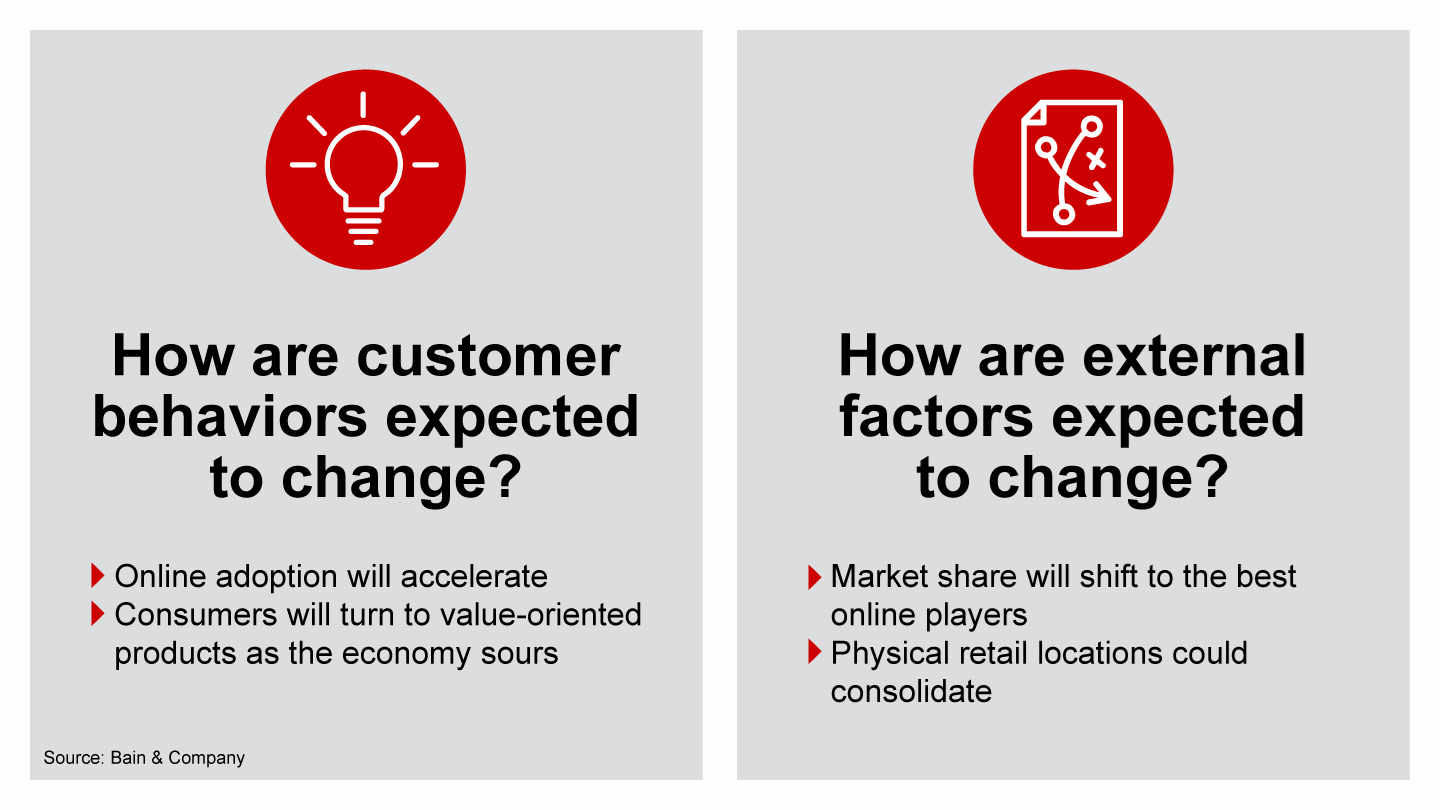
They help identify how the Covid-19 pandemic is altering that specific industry

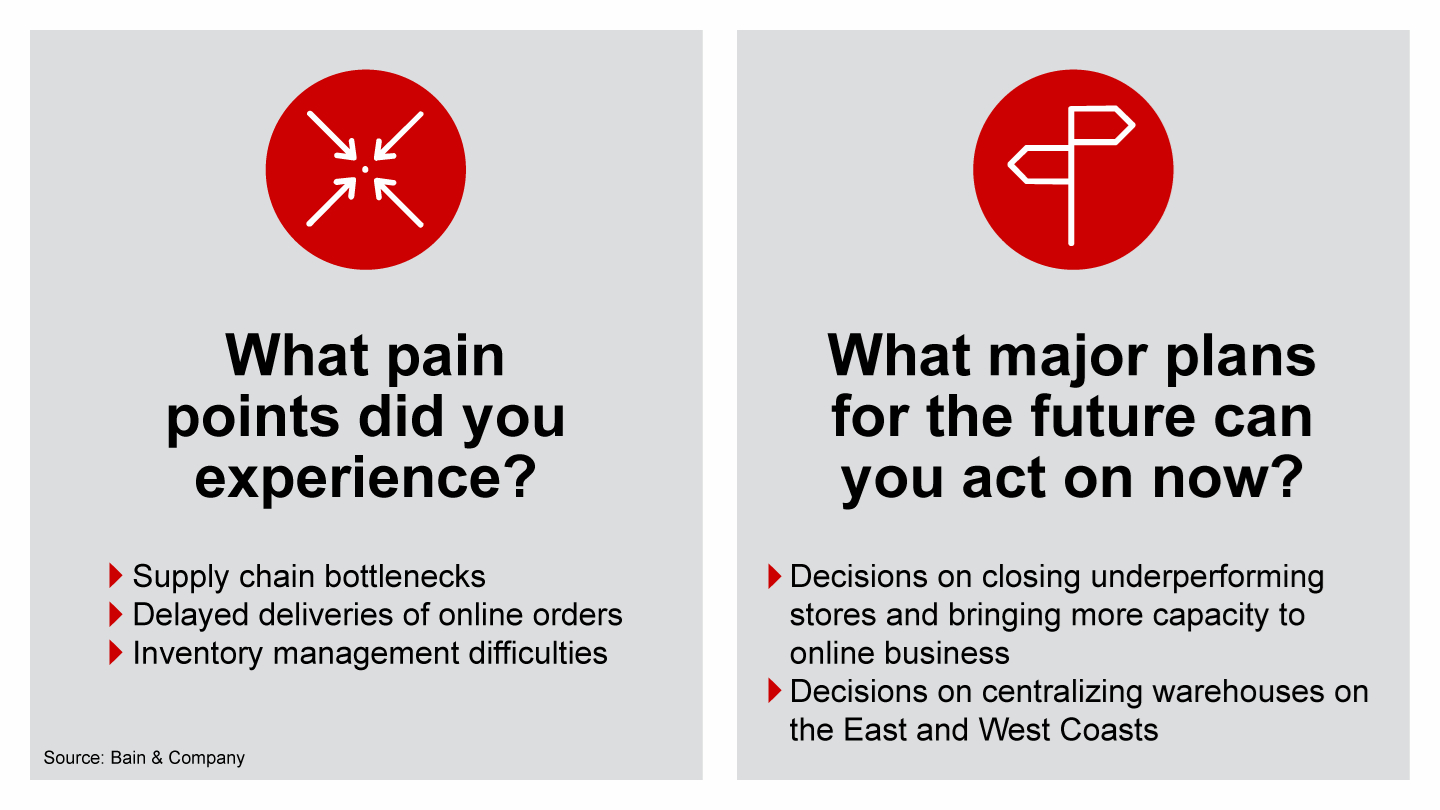
Those insights help leaders plan the right actions in specific areas of strategy and operations

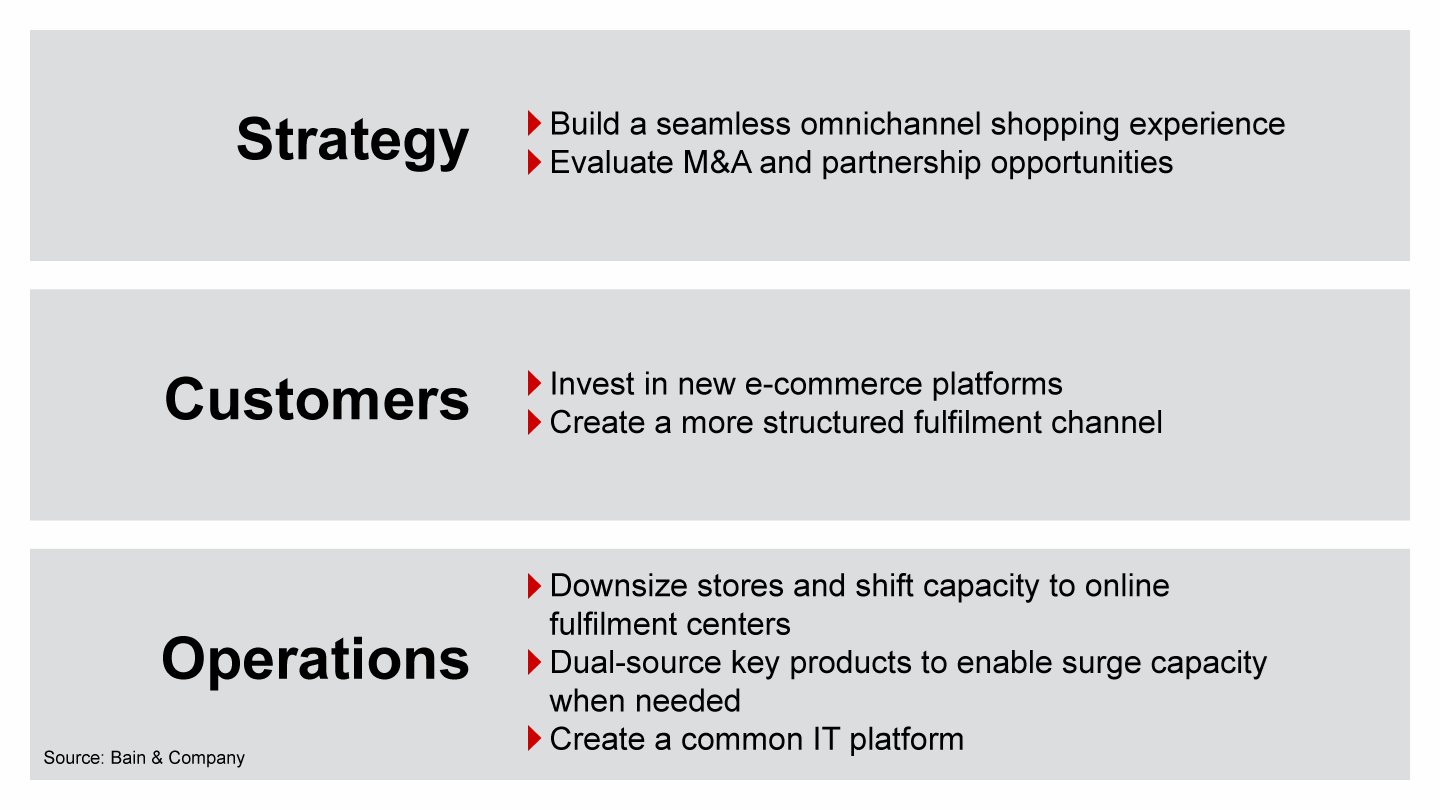
Linking planning to action ensures that quick decisions are the right decisions

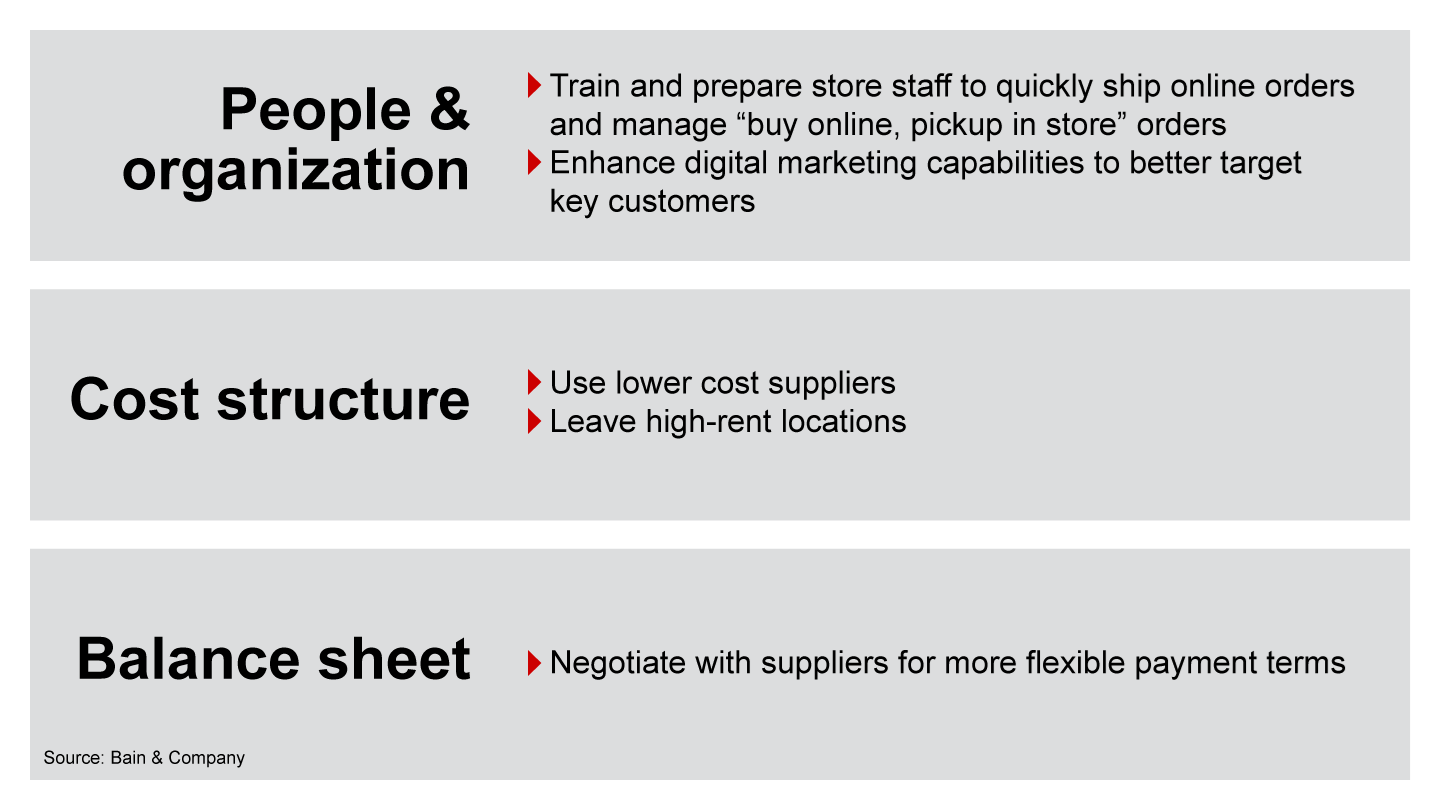
Like every company, this one scrambles to develop curbside pick-up systems at the stores that remain open and does its best to ship products to customers unwilling or unable to venture outside. At the same time, something game changing is happening: customers are actually finding it more convenient to order their dog and cat food online. “This is great! Why haven’t we been doing this all along?”
For a traditional retailer with a heavy debt load, this last question looks a lot more like danger than opportunity. What’s missing is a clear set of data signaling how much the crisis is going to accelerate change and in what direction. As revenue shrinks and cash runs thin, the most obvious response is to shutter the worst-performing stores, lay off the IT guys working on the want-to-have (not need-to-have) online initiatives, focus a skeleton staff on fulfilling orders curbside, and try to make it through the next interest payment. But are those the right decisions?
A clearer view of potential
A “plan now” exercise suggests they’re not. Before the coronavirus outbreak, the company was hardly blind to the e-commerce threat faced by its brick-and-mortar empire. But it was banking on a different competitive edge—stores that offered grooming and other on-premises services to highly loyal customers. Analytics comparing retail and online behavior before and during the crisis show that the shut-in orders are accelerating a move online, even among the least tech-savvy demographic groups. Yet the data also demonstrate that the company’s brand has never been stronger, given its heroic efforts to serve customers during a difficult time.
Armed with facts, the company’s leadership can make decisions with significantly more confidence. Coming up for air in the Covid-19 war room, they see an opportunity to prepare the company to build an omnichannel retail experience with a flexible, cloud-based e-commerce capability. It won’t happen all at once, but it will change the calculus that determines which stores to shut, whom to lay off, and what aspects of inventory management and supply chain rigor the company needs to address right away. The planning exercise also opens leadership’s eyes to how it could use M&A and partnerships in a time of distress to acquire market share, build a SaaS e-commerce capability and outsource other needs at highly favorable rates. Looking at the supply chain and inventory operations in this new context, meanwhile, triggers a series of moves to crisis-proof the flow of goods, while making distribution more efficient in an online context.
Survival still depends on managing working capital and cutting costs aggressively. It still requires making difficult short-term human resources decisions the company would rather not make. But by helping develop a more coherent and integrated view of the future, planning can now support acting and lead to sharper decisions in a future-back context. Most important, it can give the company’s PE owner a solid footing for considering new investment. While the new omnichannel strategy will clearly require fresh capital, it’s also shaping up as a rare opportunity to capture share in highly competitive market. Taking that kind of risk makes sense only if you have new and better information. Acting now depends on planning now.
One advantage PE firms have today that they haven’t had before is access to powerful analytic tools and vast new streams of market data. To discern patterns of change spurred by the Covid-19 outbreak, these tools are invaluable. The next in our series of Covid-19 Bain Briefs will break down how this works. We’ll show how firms are combining planning and analytics to gain sophisticated proprietary insights that are shaping action plans and guiding new investment.

Coronavirus
The global Covid-19 pandemic has extracted a terrible human toll and spurred sweeping changes in the world economy. Across industries, executives have begun reassessing their strategies and repositioning their companies to thrive now and in the world beyond coronavirus.
Marc Lino, Hubert Shen, Andrei Vorobyov and Hao Zhou are partners with Bain & Company’s Global Private Equity practice. They’re based in Amsterdam, Los Angeles, Copenhagen and Hong Kong, respectively.